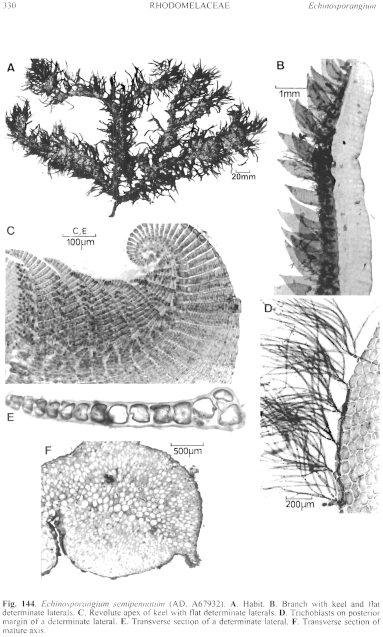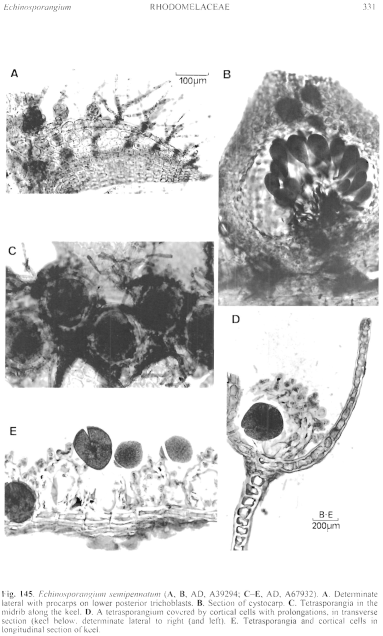|
|
|
|
|
|||||||||||
|
Electronic Flora of South Australia Species Fact Sheet
Phylum Rhodophyta – Family Rhodomelaceae – Tribe Polyzonieae
Selected citations: May 1965: 394. Silva et al. 1996: 492.
Synonyms
Amansia semipennata Lamouroux ex Poiret 1810: 310. C. Agardh 1822: 195; 1824: 248. J. Agardh 1841: 25. Decaisne 1841: 173, pl. 5 fig. 27. Harvey 1847: 24. Kützing 1849: 883; 1865: 2, pl. 3e, f. Lamouroux 1813: 270, pl. 11 figs 4, 5.
Cliftonaea semipennata (Lamouroux ex Poiret)J. Agardh 1863: 1160; 1897: 96. De Toni 1903: 1039. Lucas 1909: 44; 1929b: 51. Lucas & Perrin 1947: 289. Reinbold 1899: 48.
Cliftonaea imbricata J. Agardh 1885: 115. May 1965: 394.
Clifton(i)aea lamourouxii Harvey 1859a: text for pl. 100 (as Cliftonia); 1863: pl. 279, synop.: xv. Falkenberg 1901: 382, pl. 5 figs 26–31, pl. 10 fig. 5, pl. 24 figs 4–11. Sonder 1880: 31.
Thallus (Fig. 144A) medium to dark red-brown, 10–30 cm high, probably perennial, with robust branched axes 2–7 mm in diameter, bearing lesser branches with revolute apices developing a membranous, dorsal keel 1–2 mm broad and flat, ventral, determinate laterals (Fig. 144B) 1–2 mm long, in 2 slightly divergent rows, alternating 2 segments apart; old axes heavily corticated, denuded but covered with irregularly branched, terete to compressed, appendages. Holdfast massive, first discoid but becoming branched, 3–30 mm across; epilithic. Structure. Apices (Fig. 144C) revolute ventrally (towards the determinate laterals), apical cells dome-shaped, 15–20 µm in diameter, axial cells cutting off 6 pericentral cells, with dorsal and ventral cells and 2 lateral ones on each side; the dorsal cells divide longitudinally to form the keel and the 2 ventral lateral cells form the alternate determinate laterals separated by a single, unbranched cell. The keel is mostly 1 cell thick but may become 2 cells thick, and 17–22 cells broad with cells 35–75 µm in diameter and L/D 3–4. Determinate laterals are scalpelliform, terminally pointed, medially 10–14 cells broad, tapering to the acute tip, 1 cell thick apart from close to the indeterminate axis and the posterior margin which is 3 cells thick (Fig. 144E) with alternate segments each bearing a trichoblast (absent near the tip). Trichoblasts (Figs 144D, 145A) become 2–3 mm long, branched, basal cells 20–35 µm in diameter and L/D 1–2. Old axes become heavily corticated (Fig. 144F) with parenchymatous cells surrounding the 6 pericentral cells, and often covered with much branched, slender appendages 2–6 mm long, denuded near their base. Cells multinucleate; rhodoplasts discoid, becoming chained.
Thallus prostrate with decumbent to erect determinate laterals, or largely erect, with indeterminate and determinate laterals arising endogenously and not in regular sequences. Trichoblasts usually present on determinate laterals. Prostrate axes attached by rhizoids. Structure. Apices usually curved, dorsiventrally orientated. Pericentral cells 4–20, ecorticate in most genera. Rhizoids cut off or not from pericentral cells.
Reproduction: Gametophytes probably dioecious. Procarps (Fig. 145A) on the second cell of the basal (and sometimes up to third) trichoblast on the determinate laterals. Carposporophytes (Fig. 145B) with a small basal fusion cell and short gonimoblast with large, shortly clavate carposporangia 150–200 µm in diameter. Cystocarps subsessile, ovoid, 1–2 mm in diameter; pericarp ostiolate, heavily corticated, 5–8 cells thick. Spermatangia unknown.
Tetrasporangia occur in series in the midrib (Fig. 145C) adjacent to the keel, cut off from the ventral pericentral cells, covered by cortical cells (Fig. 145D, E) which develop outward prolongations 1–3 cells and 80–130 µm long, 40–65 µm in diameter with rounded ends; tetrasporangia 250–500 µm in diameter.
Gametophytes dioecious. Procarps borne on basal cells of trichoblasts. Carposporophytes with a branched gonimoblast and terminal carposporangia. Cystocarps ovoid, lateral on determinate laterals; pericarp ostiolate, ecorticate. Spermatangial organs borne on trichoblasts.
Tetrasporangia single or paired per segment.
Type: Type from "Nouv. Holl." (Peron); holotype in Herb. Lamouroux; isotype in PC.
Type genus: Lophosiphonia Falkenberg in Schmitz & Falkenberg 1897: 459.
Selected specimens: Eyre, W. Aust., drift (Woelkerling, 22.xi.1968; AD, A34239). St Francis Isles, S. Aust., 37 m deep (Symonds, 23.x.1973; AD, A44251). Waldegrave I., S. Aust., 22 m deep (Shepherd, 23.x.1970; AD, A37398). Marion Bay, S. Aust., drift (Womersley, 9.x.1998; AD, A67932). Investigator Strait, S. Aust., 22 m deep (Watson, 11.i.1971; AD, A39294), 32 m deep (Watson, 20.i.1971; AD, A41017), and 33 m deep (Watson, 20.i.1971; AD, A38558--"Marine Algae of southern Australia" No. 132). Gulf St Vincent, S. Aust., 40 m deep (AD, A1361). Off Port Elliot, S. Aust., dredged (Verco, Jan. 1896; MEL, 643088).
Distribution: Eyre, W. Aust., to Port Elliot, S. Australia.
Taxonomic notes: Cliftonaea imbricata J. Agardh is based on a specimen from Israelite Bay, W. Aust. (Brooke), holotype in LD, 44401. It is identical with E. semipennatum.
Group LOPHOSIPHONIEAE Kylin 1956: 538.
A group credited with 5 or 6 genera (Kylin 1956, p. 538; Hommersand 1963, p. 348), two of which occur on southern Australian coasts.
Lophosiphonia, when first described by Falkenberg in Schmitz & Falkenberg (1897, p. 459), was placed in the Herposiphonieae, but Falkenberg (1901, p. 726) later separated it from this tribe. Kylin (1956, p. 538) placed it in the Lophosiphonia group and this was followed by Hommersand (1963, p. 348). However, the Lophosiphonia group was amalgamated with the Herposiphonieae by Maggs & Hommersand (1993, p. 381) and Millar (1990, p. 452), for unstated reasons.
The Herposiphonieae are distinguished by defined but varied patterns of branching involving regularly alternating sequences of indeterminate and determinate exogenous laterals, whereas the Lophosiphonia group does not show this regular sequence and also has endogenous branching.
References:
AGARDH, C.A. (1822). Species Algarum. Vol. 1, Pt 2, pp. 169–398. (Berling: Lund.)
AGARDH, C.A. (1824). Systema Algarum. (Berling: Lund.)
AGARDH, J.G. (1841). In historiam algarum symbolae. Linnaea 15, 1–50, 443–457.
AGARDH, J.G. (1863). Species Genera et Ordines Algarum. Vol. 2, Part 3, pp. 787–1291. (Gleerup: Lund.)
AGARDH, J.G. (1885). Till algernes systematik. VII. Florideae. Acta Univ. lund. 21, 1–120, Plate 1.
AGARDH, J.G. (1897). Analecta Algologica. Cont. IV. Acta Univ. lund. 33, 1–106, Plates 1, 2.
DE TONI, G.B. (1903). Sylloge Algarum omnium hucusque Cognitarum. Vol. 4. Florideae. Sect. 3. pp. 775–1521 + 1523–1525. (Padua.)
DECAISNE, J. (1841). Plantes de l'Arabie heureuse. Archs Mus. Hist. nat., Paris 2, 89–199, Plates 5–7.
FALKENBERG, P. (1901). Die Rhodomelaceen des Golfes von Neapel und der angrenzenden Meeres-abschnitte. Fauna und Flora des Golfes von Neapel. Monogr. 26. (Friedländer: Berlin.)
HARVEY, W.H. (1847). Nereis Australis, pp. 1–69, Plates 1–25. (Reeve: London.)
HARVEY, W.H. (1859a). Phycologia Australica. Vol. 2, Plates 61–120. (Reeve: London.)
HOMMERSAND, M.H. (1963). The morphology and classification of some Ceramiaceae and Rhodomelaceae. Univ. Calif. Pubis. Bot. 35(2), 165–366.
KÜTZING, F.T. (1849). Species Algarum. (Leipzig.)
KÜTZING, F.T. (1865). Tabulae Phycologicae. Vol. 15. (Nordhausen.)
KYLIN, H. (1956). Die Gattungen der Rhodophyceen. (Gleerups: Lund.)
LAMOUROUX, J.V.F. (1813). Essai sur les genres de la famille des thalassiophytes non articulées. Ann. Mus. Hist. Nat., Paris 20, 21–47, 115–139, 267–293, Plates 7–13.
LUCAS, A.H.S. & PERRIN, F. (1947). The Seaweeds of South Australia. Part 2. The Red Seaweeds. (Govt Printer: Adelaide.)
LUCAS, A.H.S. (1909). Revised list of the Fucoideae and Florideae of Australia. Proc. Linn. Soc. N.S.W. 34, 9–60.
LUCAS, A.H.S. (1929b). A census of the marine algae of South Australia. Trans. R. Soc. S. Aust. 53, 45–53.
MAGGS, C.A. & HOMMERSAND, M.H. (1993). Seaweeds of the British Isles. Vol. 1. Rhodophyta. Part 3A, Ceramiales. (HMSO: London.)
MAY, V. (1965). A census and key to the species of Rhodophyceae (red algae) recorded from Australia. Contr. N.S. W. Natl Herb. 3, 349–429.
MILLAR, A.J.K. (1990). Marine Red Algae of the Coffs Harbour Region, northern New South Wales. Aust. Syst. Bot. 3, 293–593.
POIRET, J.L.M. (1810). Amansie. Amansia. In Lamarck, J.B. de, Encyclopedie methodique. Botanique. Suppl. 1. Paris. p. 310.
REINBOLD, T. (1899). Meeresalgen von Investigator Street (Süd Australien), gesammelt von Miss Nellie Davey (Waltham, Honiton). Hedwigia 38, 39–51.
SCHMITZ, F. & FALKENBERG, P. (1897). Rhodomelaceae. In Engler, A. & Prantl, K., Die natürlichen Pflanzenfamilien. T.1. Abt. 2, pp. 421–480. (Englemann: Leipzig.)
SILVA, P.C., BASSON, P.W. & MOE, R.L. (1996). Catalogue of the Benthic Marine Algae of the Indian Ocean. (Univ. California Press: Berkeley.)
SONDER, O.W. (1880). In Mueller, F., Fragmenta Phytographiae Australiae. Supplementum ad volumen undecinum: Algae Australianae hactenus cognitae, pp. 1–42, 105–107. (Melbourne.)
The Marine Benthic Flora of Southern Australia Part IIID complete list of references.
Publication:
Womersley, H.B.S. (24 February, 2003)
The Marine Benthic Flora of Southern Australia
Rhodophyta. Part IIID. Ceramiales – Delesseriaceae, Sarcomeniaceae, Rhodomelaceae
Reproduced with permission from The Marine Benthic Flora of Southern Australia Part IIID 2003, by H.B.S. Womersley. Australian Biological Resources Study, Canberra. Copyright Commonwealth of Australia.
KEY TO GENERA OF LOPHOSIPHONIA GROUP
|
1. Pericentral cells 4 or 6; tetrasporangia single per segment | LOPHOSIPHONIA |
|
1. Pericentral cells | OPHIDOCLADUS |
Illustrations in Womersley Part IIIA, 2003: FIGS 144, 145.

Figure 144 enlarge
Fig. 144. Echinosporangium semipennatum (AD, A67932). A. Habit. B. Branch with keel and flat determinate laterals. C. Revolute apex of keel with flat determinate laterals. II Trichoblasts on posterior margin of a determinate lateral. E. Transverse section of a determinate lateral. F. Transverse section of mature axis.

Figure 145 enlarge
Fig. 145. Echinosporangium semipennatum (A, B, AD, A39294; C–E, AD, A67932). A. Determinate lateral with procarps on lower posterior trichoblasts. B. Section of cystocarp. C. Tetrasporangia in the midrib along the keel. D. A tetrasporangium covered by cortical cells with prolongations, in transverse section (keel below, determinate lateral to right (and left). E. Tetrasporangia and cortical cells in longitudinal section of keel.

|
Email Contact: State Herbarium of South Australia |

|